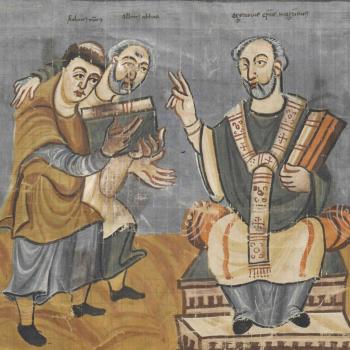British media recently presented two unrelated columns that, each in its own way, raised alarming questions about religious violence and religious politics. Putting the two reports together frames some political dilemmas that are going to be with us for years, possibly decades, into the future.
The first was a Daily Telegraph piece about the various nightmares imagined by French intelligence in the wake of the recent near-massacre on the Amsterdam–Paris train. Clearly, this is not just journalistic speculation: the authors are channeling the views of well-informed sources in French domestic intelligence, presumably the DGSI. The point is not just that many younger French Muslims are increasingly radicalized, but that they potentially have increased access to really dangerous heavy weapons, including automatic rifles, missiles, and even anti-tank armaments like Milan missiles. These are flowing into Europe from nearby battlefronts – in the Balkans, Libya and elsewhere.
There’s an irony for you. The US might (arguably) have problems with too easy access to firearms. But if you want real, heavy, military ordnance, then go to peace-loving Europe.
So how might these arms be used? Could an anti-tank weapon be used to bring down airliners landing or taking off? As we approach the anniversary of our own September 11, might the French be about to face a similar disaster?
Perhaps the most frightening single prospect in the Telegraph piece was this:
The army has made contingency plans for the “reappropriation of national territory”, meaning to win back control of neighbourhoods where the population become hostile to the security forces and where guns are easily obtainable.
And “guns” in this case means Kalashnikovs, possibly backed up by missiles. They are talking about contingency plans for the military reconquest of substantial areas of major French cities, including who-knows-how-many Paris banlieues. I would add that such a guerrilla situation would almost certainly spawn copycat movements in other large European Muslim areas, in Britain, Germany, Sweden, and elsewhere. Might those areas of armed resistance fly the IS flag? The “reappropriation of national territory”… quite a phrase.
Cut now to another story in the English Catholic Herald, in which Dominic Selwood projects “What English Catholicism Will Look Like in 2115.” Harmless enough stuff, one might think, until Selwood mentions the issue of interfaith relations, and specifically relations with Islam. Here is his projection:
The largest divisions within Islam are currently Sunni, Shia and Sufi. But a fourth group is now clearly emerging. It has no official name, but it is Salafist and jihadist…. Fuelled by the grim reality of life in war-torn, failed, or corrupt states across Africa, Asia and the Middle East – and driven by inequality, poverty, a large youthful population and social exclusion – the global reality of Salafi jihadism seems likely to result in an eventual split from the mainstream. This will formalise a separate but permanent jihadist movement within Sunni Islam.
We can argue about elements of this argument, and Selwood is not presenting himself as an Islam expert. For instance, Sufis have never been a separate component of Islam, but have always existed chiefly within the Sunni tradition. But let’s take his comment seriously.
Selwood is saying that Salafi Jihadism, following movements like al-Qaeda and IS, will remain as a permanent presence within global Islam. Is he right? Well, “permanent” is a long time, but it is difficult to see any trends in the near future that could make that jihadi tradition fade away soon. Barring miracles, it will be there for decades to come, even if the actual Islamic State was smashed within a couple of years. Our children and grandchildren will have to live in a world where that jihadi force will be an ever-threatening reality.
If that seems hard to imagine, we should consider this: imagine going back to 2001, and being told that the US would soon be trying to encourage Islamist movements that lean towards the more moderate Qaeda wing of the movement, rather than the extremists of IS. In ten years, will a future administration be confronting people even more extreme and confrontational than the Islamic State? Presently, I can imagine no such thing, but realities change. If the recent past is any guide, they become much worse.
Let’s think through that “permanent jihad” idea through in terms of ordinary life in North America or Europe. Let me play a little with what I freely admit is speculation. Not absolute worst-case scenarios, maybe, but what we might call plausible nightmares. And remember, access to heavy weapons means that in this instance, the US is at much lower risk than Europe.
Assume that successful intelligence thwarts 95 percent of attempted jihadi attacks (aided by the extraordinary incompetence of some of the would-be Holy Warriors themselves). Even so, let’s project a near-future in which, each and every year, there are perhaps a dozen successful terror outrages in Western coutnries. Twenty killed in a train massacre here, fifty slaughtered in a mall there, three hundred killed when an airliner is brought down at Heathrow or Charles de Gaulle, LAX or Newark. Four hundred French or American children taken as hostages in a re-enactment of the Beslan siege of 2004. Every week, four or five are killed when a jihadi uses his car to mow down pedestrians, or shoots up a college campus or a Jewish community center, or snipes at cars passing on urban freeways. Those “minor” local stories become so commonplace that they scarcely even make national news. They are part of the new normal.
Life changes radically, as security measures pile up. Every visit to a mall, every attempt to board a commuter train or a long-distance bus, demands security measures at least comparable to what air travelers presently face.
Assume further that there is literally no prospect of an end to such chaos: it will not end when the US withdraws its occupying forces from Country X, or indeed from the whole Middle East. As the terror networks are so diffuse and decentralized, they cannot be suppressed by neutralizing a few key operatives. Intelligence agencies can do a lot, in terms of seeking out and using surveillance against potential jihadis, but controversies over infringing civil liberties would mount quickly. So would charges of ethnic and religious profiling.
How would mainstream Americans react to such a world? Mainstream media and established politicians would respond as they do at present, stressing that the terrorists are not authentic representatives of Islam, that the supposed jihadis are unconnected individuals acting chiefly from psychopathology rather than politics. They would sternly condemn any attempt to seek revenge by attacking mosques, and praise those moderate Muslims who struggle against the jihadis.
At some point, though, surely public fury would reach such a peak as to favor harsh repression. That might mean supporting militant or extreme anti-Muslim parties, demanding quite sweeping suppression of Islamic institutions, and removing restraints on law enforcement and intelligence. Condemnations of “Salafi Jihadism” would feed rapidly into attacks on Islam and Muslims as such. That anger would of necessity feed into electoral politics.
Before anyone suggests that I am favoring or advocating such responses, I point out that my columns relating to Islam usually get denounced by hardline characters like Claire Berlinski, while Robert Spencer labels me a naïve academic fellow-traveler. I’m just posing a critical question. Is the militant jihadi tradition really here to stay as a fundamental and growing part of Islam? And if so, does the West have to learn to live with a permanent threat of lethal terrorism on its own soil? Surely, such a fact would have enormous political consequences, for European nations, but also the US.
This might be a good time to think: what would those consequences be? Are we looking at the key domestic political divisions of the 2020s?
















